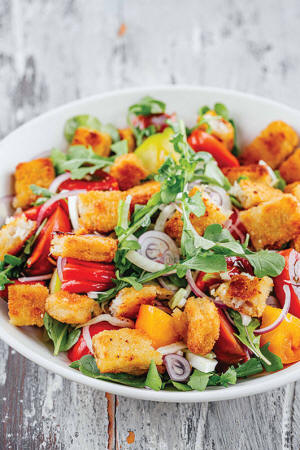A new 'Blue Food' cookbook champions fish and other seafood for any meal
[October 30, 2025]
By MARK KENNEDY
NEW YORK (AP) — Andrew Zimmern and Barton Seaver are what you'd call
seafood fanatics. Or blue food evangelists. They want us to eat more
things from the water, even first thing in the morning.
“Seafood for breakfast is delicious,” says Zimmern, a chef, writer and
TV host. Seaver, a chef and National Geographic Explorer, agrees — he
argues that some lean protein with omega-3 fatty acids is a great way to
start the day.
“Seafood belongs in all places at all meals at all times,” Seaver says.
The two — in collaboration with the ocean food advocacy nonprofit Fed by
Blue — have combined for “The Blue Food Cookbook: Delicious Recipes for
a Sustainable Future," part cookbook and part educational resource to
help make food from oceans, lakes and rivers less confusing for many
people.
“Seafood, categorically, is a food that needs a little help getting into
more people’s diets across more demographics,” says Seaver. “That was
the intent of this book — to be inviting, but also to give people a
sense that, hey, maybe it’s time to look anew at seafood.”
The two use “blue food” to describe the category, which embraces more
than just ocean food but also freshwater animals, as well as algae and
marine plants. The authors argue that picking blue food doesn't have to
be baffling, expensive or hard to cook.
“There’s so much confusing information out there,” says Zimmern.
Labels don't always help
Is wild caught better than farmed? Is fresh better than frozen? Zimmern
and Seaver discuss the pros and cons of each, but that's not really what
they care about. The labels don't always help: Thanks to technology on
trawlers, frozen fish can be fresher than unfrozen.
More important: Where is your fish from and was it sustainably caught?

"The Blue Food Cookbook" stresses that the fish at the center of any
dish can be swapped out with a similar animal in the same family. If
there's no fresh, good-looking haddock at the store, try halibut or
pollock.
The authors say consumers may be shying away from buying fish and marine
plants because of blaring headlines about depleted oceans, labor
abuses,antibiotic use and radiation. They argue those issues are dwarfed
by what's happening on land with chickens, cows and pigs.
“To be very clear, there’s a lot that we yet need to get right about
seafood. But there is so much that’s also going right currently, so many
innovations that we’ve created that have really opened the door to this
new perspective. And that’s what Andrew and I seek to celebrate,” says
Seaver.
The 145 recipes in the book go from high-brow caviar to a humble tuna
noodle casserole, and bounce from North African flavors to Nashville hot
catfish. One dish — a panzanella — seems to perfectly encapsulate their
approach; it takes frozen, pre-made fish sticks and adds heirloom
tomatoes, fennel and onion to make a new twist on a rustic Italian
salad.
[to top of second column]
|

This image released by Harvest, an imprint of HarperCollins
Publishers, shows a recipe for fish sticks on a rustic Italian salad
called panzanella. (Eric Wolfinger/Harvest via AP)

Zimmern recalls fondly when, in his childhood, Mrs. Paul’s frozen fish
sticks started to appear, and he would dip them in mayonnaise and
ketchup mixed together. "It was one of my favorite things ever,” he
says. He may have become a James Beard Award-winner but he doesn't look
down on the often-derided cafeteria staple.
“Anytime we have a meal that doesn’t rely on a Big Ag version of beef,
pork and chicken, we’re making a vote to save our planet,” Zimmern says.
“If America ate another seafood meal a week, we would be doing such a
benefit to our economy.”
Dueling recipes
The book includes cooking techniques; tips on buying fish; and must-have
pantry items. There are recipe sections for bivalves, small silver fish
like sardines, preserved and canned seafood, seaweed, flaky white fish
like cod, the salmon family, meaty dense fish like carp, steak fish like
swordfish, fillet fish like branzino, and shellfish and cephalopods,
like octopus.
The authors offer dueling recipes for crab cakes, linguini with clam
sauce and clam chowder, playfully laying out their cases for why their
version is supreme.
“We both firmly believe there’s no one way to do something that’s
right,” says Zimmern. “And in an effort to sort of poke fun at all of
those other chefs and food writers who were like, ‘No, this is the only
way to do X,’ we decided that we’re going to have multiple versions of
the same things in our book.”
As for breakfast, the authors look to ideas from Japan, China, Thailand,
India and even England, where smoked herring is traditionally eaten.
It's not so foreign a concept; in New York, salmon lox on a bagel is a
common breakfast.
Seaver even suggests bringing seafood in for lunch at the office, an
idea often considered too smelly. “There’s plenty of chilled seafood
dishes in here that don’t need to be microwaved to piss off the whole
floor.”
All contents © copyright 2025 Associated Press. All rights reserved
 |